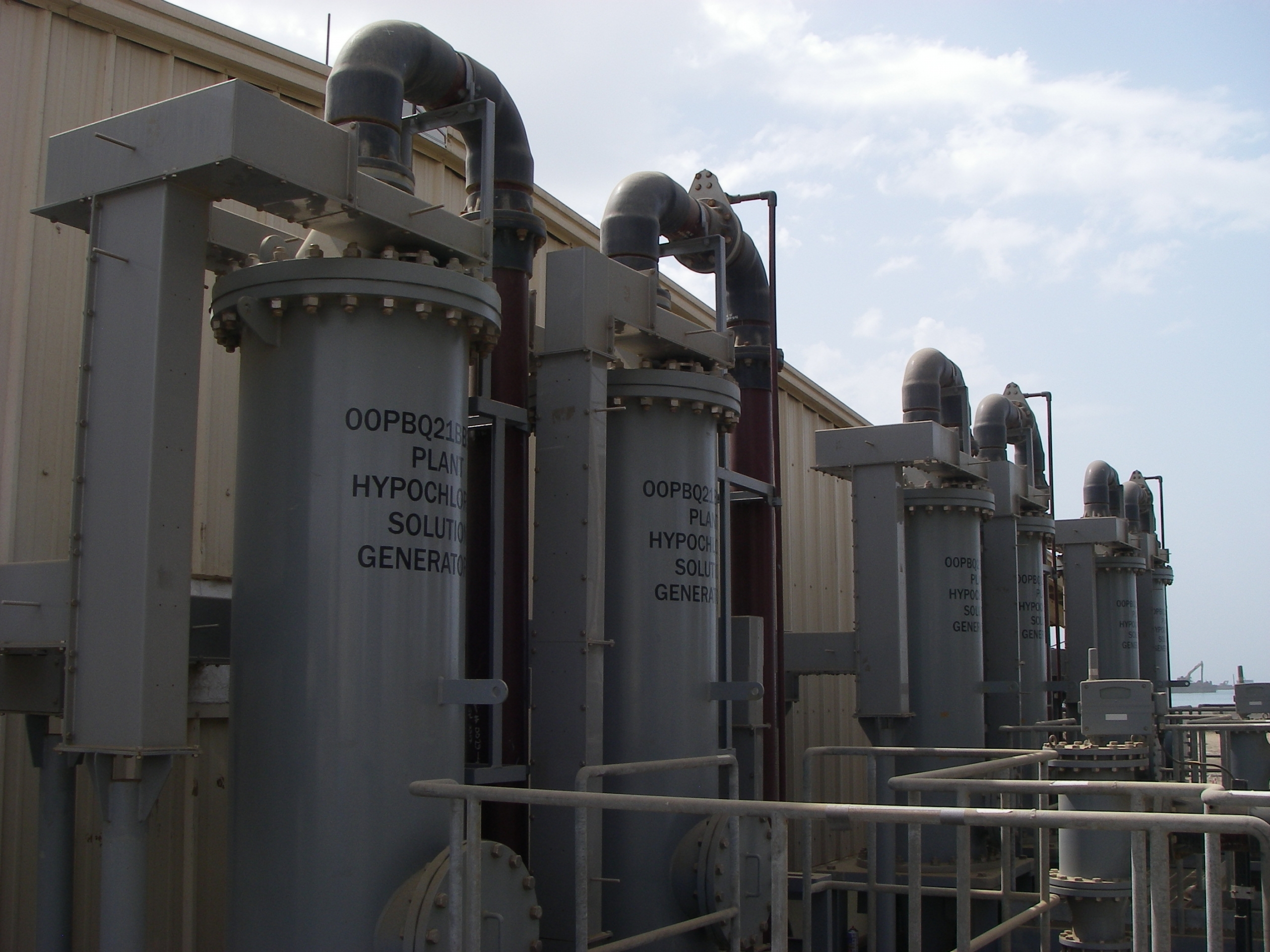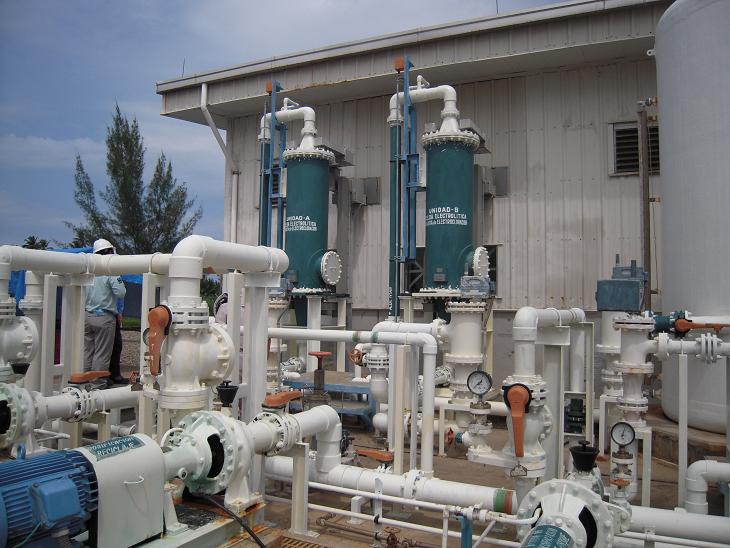Seawater electrolyte chlorine injection system is a system that helps to save energy and operation cost for a plant. During plant operation, the adhesion and reproduction of marine organisms that occur between the seawater intake and the outlet has become a major problem for operation, leading to several problems related to increasing of energy pump loss and heat exchange efficiency. Seawater electrolyte chlorine injection system provides a solution to solve the above problems.
By Okamura design technique, we collect customer inquiry and specification, then we provide an optimum solution for cost and operation. We select materials, capacities, etc. according to the water quality and usage conditions, supply safe and secure water quality with an optimum cost, and optimally meet the customers inquiries. We provide various chlorine injection equipment.
 In addition, by selecting OKAMURA’s seawater electrolyte chlorine injection system, it is possible to reduce the environmental load by up to 90%, reduce the initial cost by 10%, and reduce the operating cost by 18%.
In addition, by selecting OKAMURA’s seawater electrolyte chlorine injection system, it is possible to reduce the environmental load by up to 90%, reduce the initial cost by 10%, and reduce the operating cost by 18%.
Okamura seawater electrolyte chlorine injection system
Recycling method
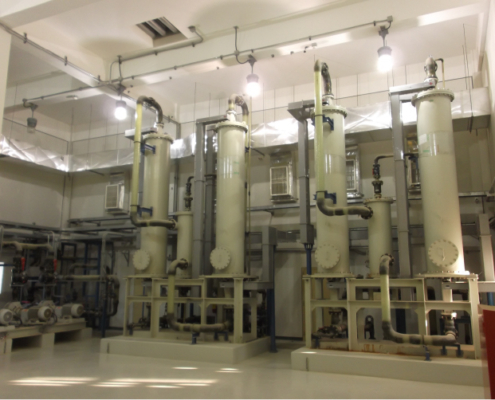 The seawater electrolyte chlorine injection system proposed by Okamura uses a recycling method. This makes it possible to install in fields that could not be handled by the conventional method (once-through method), realizing a wider range of applications.
The seawater electrolyte chlorine injection system proposed by Okamura uses a recycling method. This makes it possible to install in fields that could not be handled by the conventional method (once-through method), realizing a wider range of applications.
Main application for seawater electrolyte chlorine injection system:
| Thermal power plant | LNG / LPG terminal | Desalination plant |
| Nuclear power plant | Oil refinery / essential oil plant | Fertilizer plant |
| Chemical plant | Marine plant | Marine plant |
| Coastal water treatment plant | Other industrial plants |
What is the recycling method?
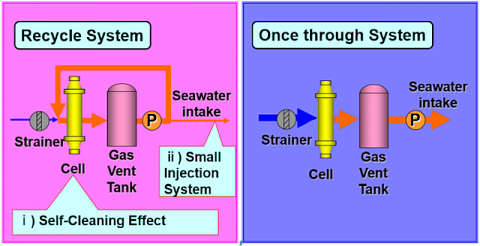 Achieves high-concentration chlorine production by recirculating NaClO from the degassing tank to the electrolytic cell. In addition, compared to the conventional method (once-through method), the electrolytic device can be kept clean for a long period of time, which makes it possible to maintain high performance and dramatically reduces the frequency of pickling for scale removal. (Once-through method: once a month ⇒ recycling method: once a year)
Achieves high-concentration chlorine production by recirculating NaClO from the degassing tank to the electrolytic cell. In addition, compared to the conventional method (once-through method), the electrolytic device can be kept clean for a long period of time, which makes it possible to maintain high performance and dramatically reduces the frequency of pickling for scale removal. (Once-through method: once a month ⇒ recycling method: once a year)
Highly efficient electrolysis and maintenance cost can be significantly reduced.
Features of recycling method
Self-cleaning effect
By adopting the recycling method, a self-cleaning effect is created in the system.
Due to its self-cleaning effect (* 1), the scale adhering to the inside of the electrode is suppressed.
* 1 What is the self-cleaning effect?
Circulated scale molecules react with the nucleus to increase the diameter of the scale, causing it to flow out and be discharged naturally.
| Recycle system | Once through system | |
|---|---|---|
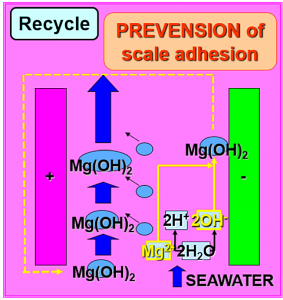 |
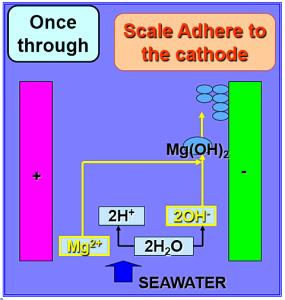 |
|
| Scale adhesion | No scale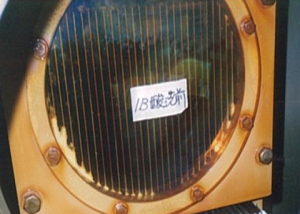 |
Scale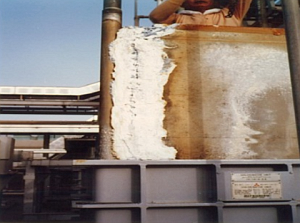 |
| Acid cleaning cycle | One year free | Once a month |
| Trouble | No trouble | Cell burning |
Adoption of high efficiency electrodes
Okamura seawater electrolyte chlorine injection system uses highly efficient electrodes, reducing costs by approximately 18% each year.
Comparison of operating costs (In case of 100 kg/hr electrolytic equipment):
| Company/Process | OKAMURA Recycle (USD) |
OKAMURA Once-through (USD) |
Others company Once through (USD) |
|---|---|---|---|
| power consumption | 321,500 (100) |
321,500 (100) |
382,600 (119) |
| Acid cleaning | 900 (Once a year) |
10,800 (Once a month) |
10,800 (Once a month) |
| total | 322,400 (100) |
332,300 (103) |
393,400 (122) |
| evaluation | ◎ | ◯ | △ |
Remarks: Electricity charge: USD 0.12 per 1KWh
◎: Very good ◯: Good △: There is a problem
Can be used in water quality environments where conventional methods cannot be applied
| Among the components contained in seawater, there are factors that significantly impair the electrolysis operation. Typical seawater electrolyte alienation factors and design standard upper limit concentrations are as follows. | Electrolyte alienation factor:
|
In a water quality environment where these electrolyte alienation factors exceed the upper limit, the amount of chlorine generated may be insufficient or the electrodes inside the electrolytic cell may be abnormally consumed in a short period of time if operated by the conventional method.
By adopting the recycling method, all of the above electrolysis inhibitors can be detoxified.
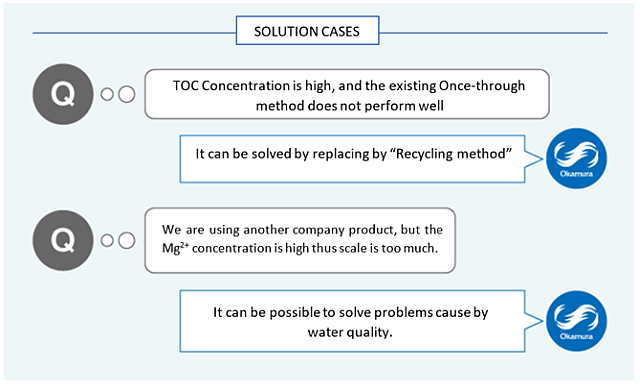
Initiatives for SDGs
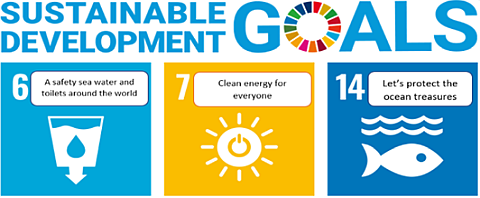 Okamura will contribute to the following items among the “Sustainable Development Goals (SDGs) by 2030”, which was adopted by the United Nations in 2015 through the seawater electrolytic chlorine injection facility and is an important goal of the international community.
Okamura will contribute to the following items among the “Sustainable Development Goals (SDGs) by 2030”, which was adopted by the United Nations in 2015 through the seawater electrolytic chlorine injection facility and is an important goal of the international community.
Equipment overview
| ① Seawater pump | : Supply seawater to the electrolyte cell. |
| ② Strainer | : The seawater supplied to the electrolytic cell is filtered in advance to prevent foreign matter from entering. |
| ③ Electrolytic cell | : Seawater is electrolyzed using a high-efficiency electrode to produce sodium hypochlorite. |
| ④ DC power supply device | : Seawater is electrolyzed using a high-efficiency electrode to produce sodium hypochlorite. |
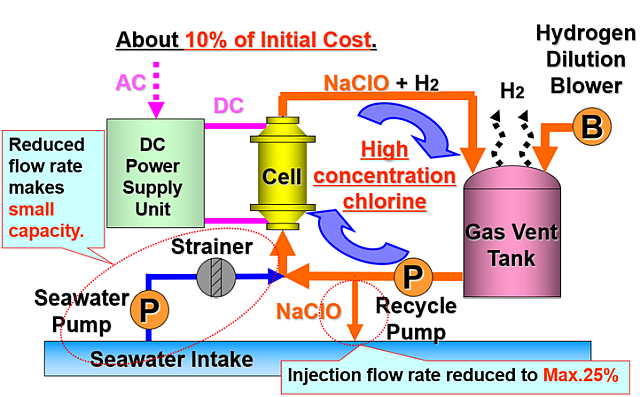
Below are request information for estimating the seawater electrolyte chlorine injection system by Okamura.
- Current required amount of seawater (m3/h)
- Injection rate (ppm)
- Seawater conditions
- Highest, lowest, average temperature (℃)
- Chloride ion concentration (ppm)
- Magnesium ion content (ppm)
- Calcium ion content (mg/L)
- SS component (mg/L)
- Other seawater conditions (optional)
- Site drawing of the planned installation site (arrangement plan)
OKAMURA
1-10-1, Shichinomiya-cho, Hyogo-ku,
Kobe, Japan 652-0831
TEL: +81-78- 652-3151

